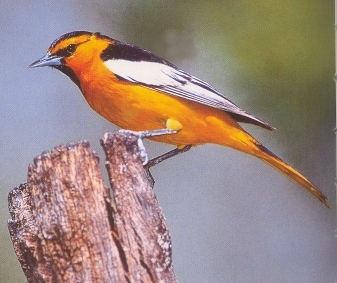
Medium oriole, mostly bright orange with black crown, eye-line, throat
stripe, back, and central tail. Wings are black with large white patches.
Forages in trees and bushes. Feeds on insects, caterpillars, fruits
and berries. Sips nectar. Strong direct flight with rapid wing beats.
|
BULLOCK’S
ORIOLE
Icterus bullockii
PASSERIFORMES
Blackbirds and Orioles (Icteridae)
Range and Habitat
Breeds from British Columbia and southern Alberta
south to southern California and Mexico, and east to
the Dakotas and Texas. Spends winters in the tropics.
Preferred habitats include deciduous woodlands, shade trees, riparian
woodlands, parks, and towns.
SOUND:
"cheah"
The Bullock's
Oriole was named after
William Bullock, an English amateur naturalist.
They are one of the few bird species that will puncture and eject Brown-headed
Cowbirds' eggs. They sometimes damage
their own eggs in the process, but the benefit of this
behavior far outweighs the cost.
From 1983-1995, they were combined with the Baltimore Oriole into a
single species, the Northern Oriole. This was due to hybridization between
the two species in the Great Plains. In 1995 the American Ornithologist's
Union resplit the Northern Oriole back into two species.
A group of orioles are collectively known as a
"pitch" and a "split" of orioles.

The Bullock's Oriole is native to Mexico, the United States, Honduras,
Guatemala, Canada and Costa Rica. The range of Bullock's Oriole is fairly
large, reaching up to nearly 4 million kilometers in its native area.
The population of this bird is thought to amount to several million
individual birds as well. Previously, this bird was rated as Lower Risk.
In 2004, the rating was change to Least Concern because of the span
of its range and its population.
|




